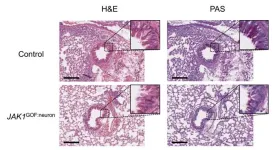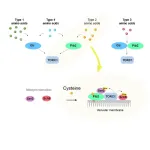(Press-News.org) A new technology developed by engineers at the University of California San Diego has the potential to make the extended reality (XR) experience smoother and more seamless. The technology consists of an asset localization system that uses wireless signals to track physical objects with centimeter-level accuracy in real time, and then generates a virtual representation of these objects. Applications of this technology range from enhancing virtual gaming experiences to improving workplace safety.
The team, led by Dinesh Bharadia, a professor in the Department of Electrical and Computer Engineering at the UC San Diego Jacobs School of Engineering, presented the technology at the ACM Conference on Embedded Networked Sensor Systems (SenSys 2023) held in Istanbul, Turkey.
Existing localization methods encounter significant limitations. For example, many XR applications use cameras to localize objects, whether it be through virtual reality (VR) devices, augmented reality (AR) glasses or smartphone cameras, said study co-first author Aditya Arun, who is an electrical and computer engineering Ph.D. student in Bharadia’s lab.
“However, these camera-based methods are unreliable in highly dynamic scenarios with visual obstructions, rapidly changing environments or poor lighting conditions,” said Arun. Meanwhile, wireless technologies such as WiFi and Bluetooth Low Energy (BLE) often fall short in providing the required accuracy, and ultrawide-band (UWB) technology involves complex setup and configuration.
The new asset localization system developed by Bharadia’s team at UC San Diego, in collaboration with Shunsuke Saruwatari at Osaka University, Japan, overcomes these limitations by providing accurate, real-time localization of objects with centimeter-level accuracy, even in dynamic and poorly lit environments. The system is also packaged in an easily deployable and compact module, measuring one meter in size, that could be incorporated into electronic devices like televisions or sound bars with minimal setup.
The researchers built their system by harnessing the power of wireless signals in the sub-6 GHz regime. “Unlike camera-based methods, these wireless signals are less affected by visual blockages and continue to operate even in non-line-of-sight conditions,” said Arun.
The system uses wireless signals to pinpoint battery-operated UWB tags that are attached to objects. It consists of two main components. One is a UWB tag that transmits a beacon signal for localization. The other component is a localization module equipped with six UWB receivers that are time and phase-synchronized to receive the beacon signal. As this signal travels, it reaches each receiver at a slightly different phase and time. The system combines these differences in a clever way to accurately measure the tag’s location in 2D space.
In tests, the researchers used their system to play a life-size chess game using everyday objects. They retrofitted mugs with off-the-shelf UWB tags, transforming them into virtual chess pieces. As the pieces were moved around on a table, the system was able to smoothly track their movements in real time with centimeter-level accuracy.
“We found that our system achieves 90th percentile accuracy in dynamic scenarios and performs at least eight times better than state-of-the-art localization systems,” said Arun.
The team is currently refining the system. Next steps include improving the PCB design to make the system more robust, reducing the number of receivers to improve energy efficiency, and adding antennas along the vertical axis to support full 3D localization.
Paper title: “XRLoc: Accurate UWB Localization to Realize XR Deployments.” Co-authors include Aditya Arun*, Sureel Shah and Dinesh Bharadia, UC San Diego; and Shunsuke Saruwatari*, Osaka University, Japan.
*These authors contributed equally to this work.
END
Wireless tracking system could help improve the XR experience
2023-12-21
ELSE PRESS RELEASES FROM THIS DATE:
Fleeing drought, vulnerable populations face flood risk in most African countries
2023-12-21
American Geophysical Union
Press Release 23-47
21 December 2023
For Immediate Release
This press release is also available online at: https://news.agu.org/press-release/fleeing-drought-vulnerable-populations-face-flood-risk-in-most-african-countries
AGU press contact:
Liza Lester, +1 (202) 777-7494, news@agu.org (UTC-5 hours)
Contact information for the researchers:
Serena Ceola, University of Bologna, serena.ceola@unibo.it (GMT+1 hours)
WASHINGTON — In 80% of African countries, moved toward rivers and into cities during or following drought, increasing the number of people living in flood-risk areas in ...
The future of canine stem cell therapy: unprecedented, painless, and feeder-free
2023-12-21
Osaka, Japan – Dog owners may need to learn to appreciate their best friend’s urine. Scientists at Osaka Metropolitan University have devised an efficient, non-invasive, and pain-free method to reprogram canine stem cells from urine samples, bringing furry companions one step closer to veterinary regenerative treatment.
Induced pluripotent stem cells (iPSCs) have been widely employed in studies on human generative medicine. With the growing importance of advanced medical care for dogs and cats, there is an expectation that new therapies utilizing iPSCs will ...
New insights revealed on tissue-dependent roles of JAK signaling in inflammation
2023-12-21
Researchers at the Icahn School of Medicine at Mount Sinai have gained a deeper understanding of the nuanced roles of JAK inhibitors, or modulators, in inflammation across various cell types and tissues. Their findings suggest a more precise approach is required to potentially expand JAK inhibitor use to a wider range of allergy and inflammatory disorders. Details on the findings were published in the December 21, 2023, issue of the journal Cell.
JAK1 is a key protein in the body that supports cell communication and controls the immune system. It is part of ...
Researchers discover key to epithelial cell growth
2023-12-21
RESEARCHERS DISCOVER KEY TO EPITHELIAL CELL GROWTH
Australian researchers have discovered a new way that epithelial cells, which form layers in organs like the skin and stomach, attach to one another, and how they perceive growth signals at these attachments, helping them form tissues of the right size and shape.
Epithelial cells cover the surfaces of most organs in the body and must adhere to each other to form both a protective and permeable barrier. They are exquisitely designed to both be tightly sealed against pathogens like bacteria, and to also allow the transport of salts, fluids, and nutrients.
Researchers, led by Professor Kieran Harvey and Dr Benjamin Kroeger, at the ...
Race and ethnicity of infants enrolled in neonatal clinical trials
2023-12-21
About The Study: This systematic review of 120 studies with 14,000 participants found that Asian, Black, Hispanic, and Indigenous (e.g., Alaska Native, American Indian, and Native Hawaiian) participants were underrepresented in neonatal clinical trials, while white participants were overrepresented. There was wide variation in the terms used to report race and ethnicity data, and geographic representation was unevenly distributed, with some central and western U.S. regions underrepresented.
Authors: Elliott M. Weiss, M.D., M.S.M.E., of the University of Washington School of Medicine in Seattle, is the corresponding author.
To access the embargoed study: Visit our For ...
Wearable biosensing to predict imminent aggressive behavior in psychiatric inpatient youths with autism
2023-12-21
About The Study: The results of this study involving 70 youths with autism across four psychiatric inpatient hospitals suggest that wearable biosensing and machine learning may hold promise for identifying objective indicators of impending aggressive behaviors in youths with autism who are psychiatric inpatients. The findings may lay the groundwork for developing just-in-time adaptive intervention mobile health systems that may enable new opportunities for preemptive intervention.
Authors: Matthew S. Goodwin, Ph.D., of Northeastern University in Boston, is the corresponding author.
To access the embargoed study: ...
Back to the future: Weizmann Institute scientists develop the first method to measure cellular changes in the body over time
2023-12-21
While physicists continue to argue about whether time is indeed an illusion, as Albert Einstein claimed, biologists have no doubt about its significance for understanding life as a dynamic system. In recent years, they have been gaining an increasingly deeper understanding of complex biological systems using tools enabling the simultaneous analysis of vast amounts of cellular and molecular data and the probing of cellular circuitry that drives disease. However, these in-depth investigations of how cells behave and interact have provided only separate snapshots of what happens inside complex organisms, without accounting ...
The key mechanism to cell growth has been elucidated
2023-12-21
Osaka, Japan – Amino acids are the building blocks of life. We obtain them from the food we eat, and the body uses them to make proteins, which in turn are used for growth, development, and a multitude of other functions. However, before the body can build with these blocks, it must first be able to sense their presence.
When amino acids are available, a master regulator protein called TORC1 is switched on, causing proteins to be manufactured and cells to grow. If no amino acids are available, TORC1 is switched off, and cells start to recycle themselves in a process known as autophagy. Until now, it was unclear exactly how amino acids triggered the TORC1 switch in yeast.
Now, in a study ...
One of the keys to healthy sleep and blood sugar has been found
2023-12-21
Osaka, Japan – Only recently was it discovered that amino acids, the building blocks of proteins, exist in two different forms: L- and D-forms. While all natural proteins consist exclusively of L-amino acids, the function of D-amino acids remained poorly understood, despite being present in the food we eat every day.
Now, a multi-institutional research team led by Osaka University has revealed a function of one D-form amino acid: D-alanine. So, what does it do, and how did they uncover its function? To understand, we need a little background information.
The circadian clock, a natural ...
Artery calcification more common in night owls
2023-12-21
Artery calcification is almost twice as common in night owls compared to early birds, according to a study from the University of Gothenburg, Sweden. Circadian function appears to be particularly important during the early stages of cardiovascular disease.
Atherosclerosis involves fatty deposits accumulating on the inside of the arteries, making it harder for blood to pass through. The disease develops over a very long period of time and is not noticed until it leads to blood clots causing angina, heart attack, or stroke. Previous research has shown that people with late-night habits have an increased risk of cardiovascular disease, but this is the first study to show how circadian rhythms ...





